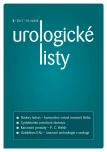Robot assisted radical cystectomy: the Mayo Clinic technique
Authors:
C. O. Mmeje; E. P. Castle
Published in:
Urol List 2012; 10(3): 29-33
Overview
Robot-assisted radical cystectomy (RARC) is the latest minimally invasive treatment of bladder cancer. The technique of RARC allows for the following potential advantages: minimal blood loss, decreased fluid shifts, and smaller surgical incisions, while still maintaining sound oncologic surgical princles. All benefits theoretically translate into less patient morbidity and shorter convalescence. We describe the operative technique of RARC, robot-assisted extended pelvic lymph node dissection, and intracorporeal/ /extracorporeal urinary diversion.
Key words:
bladder cancer, robot assisted, radical cystectomy, urinary diversion
Sources
1. Portis AJ, Yan Y, Landman J et al. Long-term followup after laparoscopic radical nephrectomy. J Urol 2002; 167(3): 1257–1262.
2. Badani KK, Kaul S, Menon M. Evolution of robotic radical prostatectomy: assessment after 2766 procedures. Cancer 2007; 110(9): 1951–1958.
3. Menon M, Hemal AK, Tewari A et al. Nerve-sparing robot-assisted radical cystoprostatectomy and urinary diversion. BJU Int 2003; 92(3): 232–236.
4. Ng CK, Kauffman EC, Lee MM et al. A Comparison of Postoperative Complications in Open versus Robotic Cystectomy. Eur Urol 2009; 57: 274–282.
5. Martin AD, Nunez RN, Pacelli A et al. Robot-assisted radical cystectomy: intermediate survival results at a mean follow-up of 25 months. BJU Int 2009; 105: 1706–1709.
6. Stein JP, Skinner DG. Results with radical cystectomy for treating bladder cancer: a 'reference standard' for high-grade, invasive bladder cancer. BJU Int 2003; 92(1): 12–17.
Labels
Paediatric urologist UrologyArticle was published in
Urological Journal

2012 Issue 3
Most read in this issue
- Rare complicaton of insertion double J stent – migration to right heart atrium
- Continent and incontinent urinary diversion, bladder sparing approaches
- Current view on small renal masses
- Robot assisted radical cystectomy: the Mayo Clinic technique
